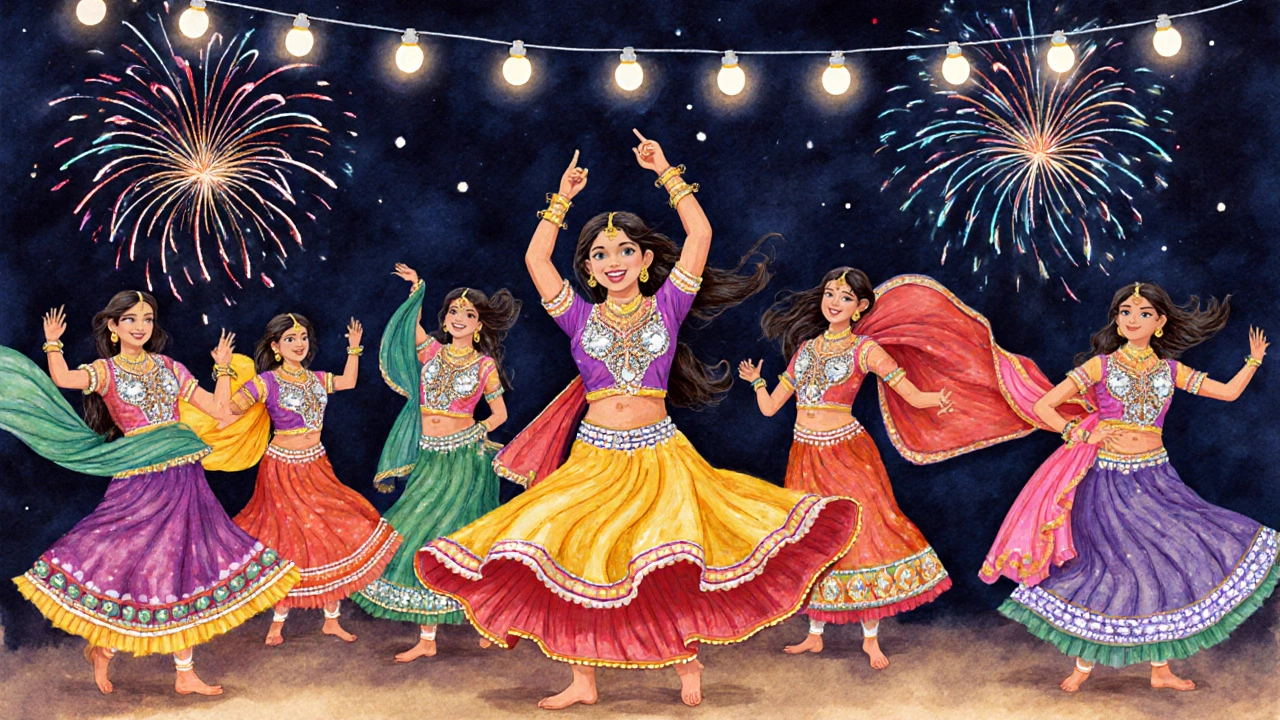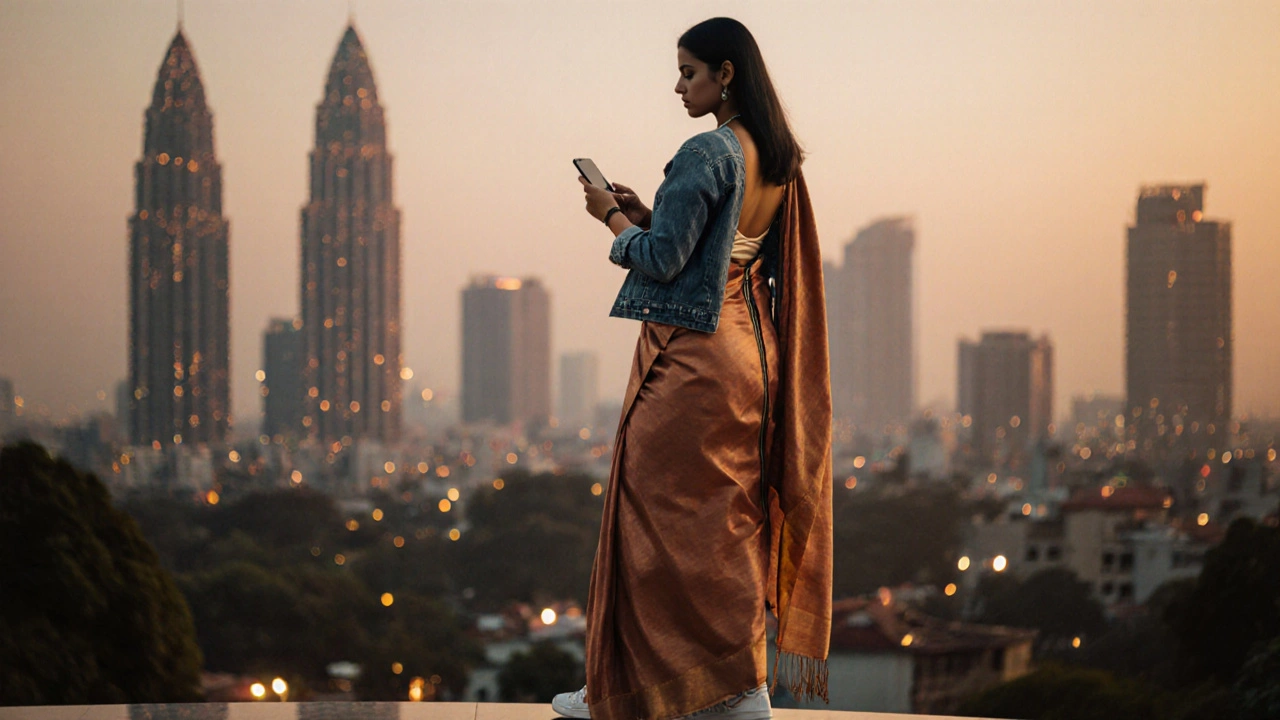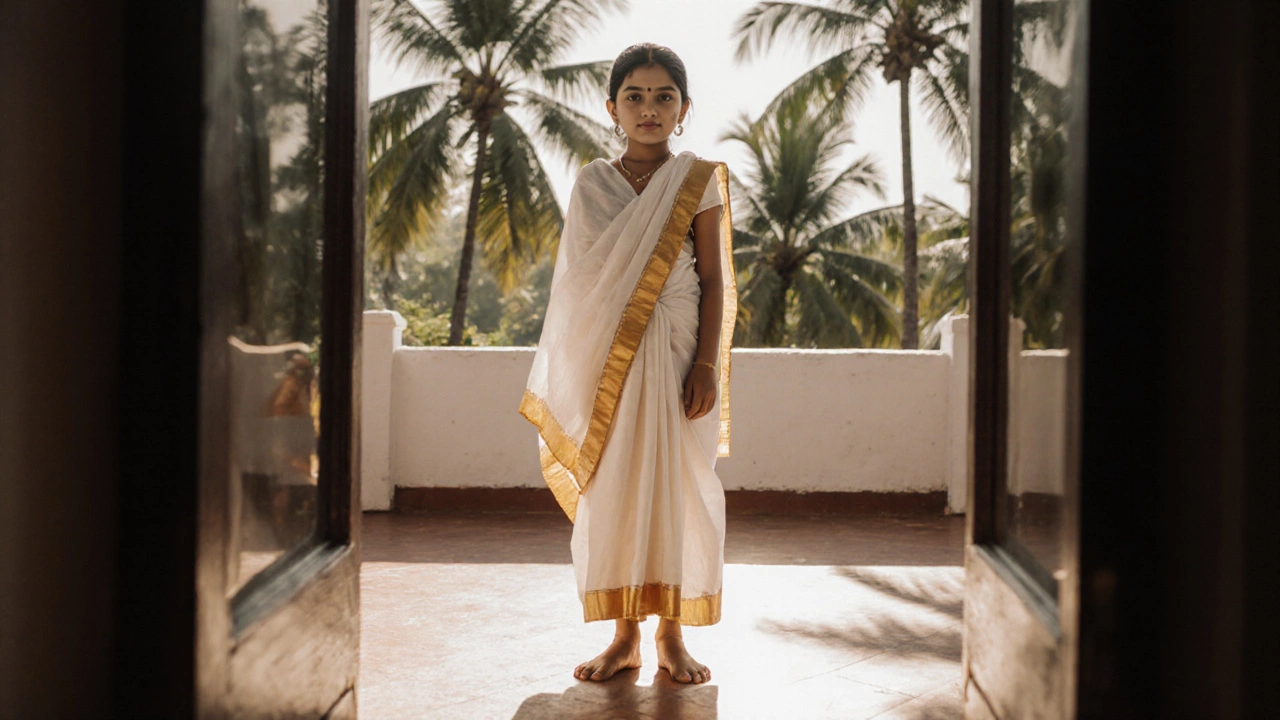Indian Outfit Finder
When you see photos of Indian girls in traditional outfits, it’s easy to think there’s one single look-maybe a bright saree or a flowy lehenga. But the truth? There’s no one answer. What Indian girls wear depends on where they’re from, what day it is, and sometimes even what time of year it is. India isn’t one country with one style. It’s 28 states and 8 union territories, each with its own clothes, customs, and ways of tying a dupatta.
It Starts With the Region
In South India, especially in Tamil Nadu and Kerala, girls often wear the saree-but not like you might picture. The Kanchipuram silk saree, worn with a matching blouse and a petticoat, is draped in the classic Nivi style. But in Kerala, the Mundum Neriyathum is more common: two pieces of cotton, one wrapped around the waist, the other over the shoulder, often in white with gold borders. It’s simple, elegant, and worn even to school.
In the North, especially in Uttar Pradesh and Punjab, the lehenga-choli is the go-to for weddings and festivals. Think voluminous skirts, heavily embroidered blouses, and a long dupatta that flows like a river. Girls as young as 10 wear these for Diwali or Raksha Bandhan. But everyday wear? That’s usually a salwar kameez-a tunic top, loose pants, and a scarf. It’s comfortable, practical, and worn from Delhi to Jammu.
Go to Maharashtra, and you’ll see the nauvari saree-nine yards of fabric wrapped like pants. It’s worn by women working in fields or dancing at folk festivals. In Gujarat, the chaniya choli is popular: a flared skirt with mirror work, paired with a short blouse and a dupatta that’s pinned over one shoulder. It’s flashy, fun, and made for dancing during Navratri.
What About Everyday Wear?
Not every girl wears a saree to college. In cities like Bangalore, Hyderabad, or Pune, you’ll see a mix. Many young Indian girls wear jeans and kurtas. The kurta-a long tunic-can be plain or printed, and it pairs easily with leggings or palazzo pants. It’s the modern version of the salwar kameez: still traditional, but easier to move in.
Outside cities, in villages across Bihar, Odisha, or Madhya Pradesh, you’ll still see girls in cotton sarees or chaniya cholis every day. These aren’t fancy outfits. They’re made of cotton, often handwoven, and washed by hand. The colors are softer-earthy reds, mustard yellows, deep greens. These clothes aren’t bought in malls. They’re bought from local weavers or passed down from mothers and grandmothers.
Weddings and Festivals Change Everything
When it’s time for a wedding, everything changes. A girl might wear a red lehenga with zari embroidery, heavy gold jewelry, and a veil that trails behind her. In Bengal, brides wear a red and white saree with black borders-the classic Shari. In Rajasthan, brides wear a lehenga with mirror work and gota patti embroidery. In South India, brides wear a silk saree with gold borders, often draped with a flower garland.
Festivals matter too. During Diwali, girls wear new clothes-often in bright colors like fuchsia, gold, or turquoise. During Holi, they wear old cotton clothes they don’t mind getting stained. During Navratri in Gujarat, girls wear chaniya cholis and dance all night. Each outfit has meaning. Red means luck. Gold means prosperity. White means purity.

How Do They Wear It?
It’s not just the fabric-it’s how it’s worn. A saree isn’t just thrown on. It’s pleated, tucked, and draped with precision. A dupatta isn’t just a scarf-it’s draped over the head during prayers, over one shoulder for a walk, or pinned at the chest for a formal event. In some communities, girls learn to drape a saree by age 12. In others, they wait until marriage.
Accessories matter too. In the East, girls wear conch shell bangles. In the West, they wear lac bangles. In the North, jhumkas-large, dangling earrings-are common. In the South, temple jewelry with gods and goddesses carved into gold is worn on special days.
What’s Changing?
Young Indian girls today are blending traditions with modern life. You’ll see a girl in a denim jacket over a silk saree. Or a lehenga with sneakers. Designers in Mumbai and Delhi are making sarees with zip backs and stretch fabric. Some girls wear pre-stitched sarees that take only two minutes to put on.
But even with these changes, the core stays the same. Clothes still carry identity. A girl from Kerala won’t wear a chaniya choli to her grandmother’s funeral. A girl from Punjab won’t wear a saree to a Bhangra party. These aren’t just outfits-they’re stories.
Why It Matters
When you ask, "What do Indian girls wear?" you’re not asking about fashion. You’re asking about culture. These clothes are tied to religion, history, and family. They’re made by hand, passed down, and worn with pride. They’re not costumes. They’re living traditions.
And they’re not disappearing. Even in Australia, where I live in Brisbane, you’ll see Indian girls wearing sarees to Diwali parties. They’re not trying to be exotic. They’re just being themselves.
| Region | Common Outfit | Key Features |
|---|---|---|
| North India (Punjab, UP) | Lehenga-choli, Salwar kameez | Embroidered, bright colors, dupatta |
| South India (Tamil Nadu, Kerala) | Saree (Nivi, Mundum Neriyathum) | Silk or cotton, gold borders, draped over shoulder |
| West India (Gujarat, Maharashtra) | Chaniya choli, Nauvari saree | Mirror work, flared skirt, 9-yard drape |
| East India (Bengal, Odisha) | Saree (Tant, Baluchari) | White-red combo, intricate weaving, no blouse |
| Rajasthan | Lehenga with gota patti | Heavy embroidery, mirror work, vibrant hues |

Common Misconceptions
One big myth is that all Indian girls wear sarees. They don’t. Many wear kurtas, jeans, or western dresses daily. Another myth is that traditional clothes are only for older women. That’s not true. Teenagers wear lehengas to school events. Kids wear miniature versions of their mother’s outfits during festivals.
Another misunderstanding? That these clothes are expensive. Sure, a silk Banarasi saree can cost thousands. But a cotton salwar kameez from a local market? That’s under $15. Many families buy second-hand or make clothes at home.
What to Wear If You’re Not Indian
If you’re invited to an Indian wedding or festival and aren’t sure what to wear, here’s the rule: go for color, not coverage. Avoid white or black-they’re for mourning. Pick a bright color like red, pink, or gold. A simple kurta with leggings works. A printed scarf over your shoulders is enough. Don’t try to copy a lehenga unless you’re told to. Respect matters more than perfection.
Do all Indian girls wear sarees?
No. While sarees are common in some regions like South India, many girls in the North and West wear salwar kameez, lehengas, or even modern outfits like kurtas with jeans. What they wear depends on where they live, the occasion, and their personal style.
What do Indian girls wear to school?
In many schools, especially in cities, girls wear uniforms-often a white shirt and navy skirt or trousers. In rural areas or private schools with cultural programs, they might wear a cotton salwar kameez or a simple saree. But outside school, they often wear casual kurtas and leggings.
Are traditional Indian clothes uncomfortable?
Not necessarily. Cotton sarees and salwar kameez are designed for hot weather. The loose fit lets air flow. Modern versions have stretch fabric, pre-stitched drapes, and lighter materials. The discomfort comes from wearing heavy jewelry or too many layers-not the clothes themselves.
Can Indian girls wear western clothes?
Absolutely. In cities, jeans, t-shirts, and dresses are everyday wear. Many girls switch between western and traditional outfits depending on the day. At work, they might wear a suit. At a festival, they wear a lehenga. It’s not about choosing one over the other-it’s about having both.
Why do Indian girls wear so much jewelry?
Jewelry isn’t just decoration. In many cultures, it’s part of identity. Nose rings mean married status. Bangles signify prosperity. Gold is often given as dowry or inheritance. Even simple silver earrings carry family meaning. It’s not about showing off-it’s about carrying history.
Final Thought
There’s no single answer to what Indian girls wear. It’s not one outfit. It’s hundreds. It’s silk in Tamil Nadu, cotton in Bihar, mirror work in Gujarat, and zari in Uttar Pradesh. It’s the way a girl ties her dupatta before leaving the house. It’s the way her mother taught her to drape a saree. It’s the way she wears her grandmother’s bangles on her wedding day.
These clothes aren’t relics. They’re alive. And every girl who wears them-whether in Delhi or Brisbane-is keeping a story alive.
